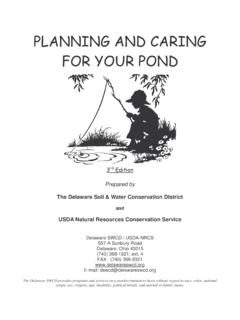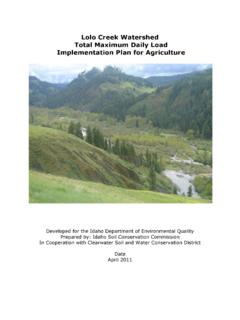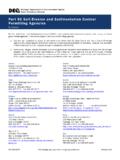Transcription of How to Order: Scioto Soil and Water
1 How to Order: Orders will be taken until Wednesday, February 21, 2018. Tentative order distribution date is the last Friday in March. Please plan for pick-up on this date. A postcard or email will be sent to confirm exact pick up date, location, and time. Be sure to include the number of packets ordered and your correct address and telephone number on the order form. Please complete the enclosed order form and mail it with your payment to: You may also place orders by stopping in our office between the hours of 7:30 and 4:00 , Monday through Friday.
2 If you have any questions, please call 740-259-9231 ext. 4 For additional order forms or for additional details visit The Scioto soil and Water Conservation District reserves the right to substitute species in the Specialty Tree Packets, Erosion Control Seed Mix, Wildlife Food Plot Seed Mix and Pollinator Seed Mixes based upon availability. NOTE: The Hard Mast Packet and Moist Soils Packet contains four (4) of each of the five species listed in the brochure. There are a total of twenty (20) seedlings per packet.
3 The Pollinator Packet contains two (2) of each of the five species listed in the brochure. There are a total of ten (10) seedlings per packet. SEEDLING SIZE: Tree and shrub seedlings should be between 6 and 18 inches tall, depending on the species. Seedlings should be planted within 5 days after pick-up and then watered regularly. Scioto SWCD 12167A State Route 104 Lucasville OH 45648 Scioto soil and Water Conserva on District Scioto SWCD 12167A State Route 104 Lucasville OH 45648 740-259-9231 ext.
4 4 Order Deadline February 21, 2018 Deciduous Trees Black Cherry (Prunus serotina) Commercially important tree growing to 60+ ft. at maturity; commonly used for lumber, veneer, and furniture. Leaves are dark green in summer and yellowish in fall. The small black fruit provides food for a variety of birds and mammals. Tolerates a wide variety of growing conditions. Black Walnut (Juglans nigra) A rapidly growing tree common in all of Ohio, is most common in moist bottomlands and open fields, but is found everywhere due to squirrels burying its nuts.
5 It has dark green compound leaves and produces delicious nuts that are preferred by wildlife. It is valued for timber, veneer, and furniture. Grows well in most locations, but prefers fertile, deep soils. Mature height and spread is 70 ft. Prefers full to part sun. Northern Red Oak (Quercus rubra) Tall, relatively fast growing tree that can reach 80+ ft. at maturity. Leaves are shiny green in summer and bright red in fall. Makes an excellent tree for street or yard. Prefers full sun and acidic soil .
6 It has a commercial value for furniture and lumber. Yields acorns that are round and 1inch long with a flat, thick, saucer-like cap. Acorns from this tree are at the top of the food preference list for blue jays, wild turkeys, squirrels, small rodents, whitetail deer, raccoons and black bears. Deer also browse the buds and twigs in wintertime. Sugar Maple (Acer saccharum) This large shade tree, which can reach heights over 100 ft., is the cornerstone of the maple syrup industry. The medium green leaves can turn brilliant yellow, orange, or red in the fall.
7 Prefers partial to full sun and well-drained soil . Excellent shade tree. White Oak (Quercus alba) A large, broadleaf tree growing to 100+ ft. at maturity. This species is shade tolerant, found on a variety of sites, and grows best in deep, sandy loam soil on south and west facing slopes. A great species for wildlife. Yields acorns that are up to 1 inch long with a warty cap that covers about of the nut. The acorns are one of the best sources of food for wildlife and are gathered, hoarded and eaten by birds, hoofed browsers and rodents.
8 Leaf buds also are eaten by several bird species, and all parts of the tree are a favorite food for deer. 2018 Tree pick up will be Friday only - Please plan accordingly. 2 11 Care on Arrival Tree seedlings require Water and cool temperatures to survive until planted. If you intend to plant the trees within a week (recommended), keep them in the shipping package in a cool or shaded location, such as a cooler (above freezing), basement, outbuilding, or on the north side of a building. If planting will be delayed longer than a week, open the package, make sure the roots and packing materials are damp, reseal, and store the package in a cool place, periodically checking the condition of the trees roots.
9 Or, dig a trench deep enough to accommodate the roots and plant the seedlings, packing soil around their roots. (See illustration below.) Do not allow the roots to dry out. Roots should be kept MOIST, not WET. Do not store seedling roots submerged in Water . Don t Test! Plants need proper nutrients to reach their full genetic potential. soil sampling allows us to determine if plant needs can be met or if we need to make amendments to our soil so plants can grow their best. It s inexpensive and it s easy! Sample in spring or fall when grass is no longer actively growing.
10 soil properties vary from place to place. The sample should be representative of the area to be sampled as a whole. Do not take samples from an unrelated area. Remove plant debris or turf from soil surface at sample site. Sample lawns, gardens, and fields to a depth of 6-8 inches. Using a clean plastic bucket and a soil probe or spade, combine cores or slices of soil from at least ten locations per acre scattered throughout the area to be tested. Break up clumps, mix soil thoroughly, and air dry at room temperature. Place one pint of sampled soil in bag.






